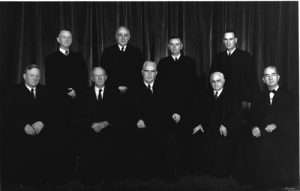The Volokh Conspiracy
Mostly law professors | Sometimes contrarian | Often libertarian | Always independent
Today in Supreme Court History: October 18, 1960
10/18/1960: Gomillion v. Lightfoot argued.

Editor's Note: We invite comments and request that they be civil and on-topic. We do not moderate or assume any responsibility for comments, which are owned by the readers who post them. Comments do not represent the views of Reason.com or Reason Foundation. We reserve the right to delete any comment for any reason at any time. Comments may only be edited within 5 minutes of posting. Report abuses.
Please to post comments


Rivas-Villegas v. Cortesluna, 595 U.S. 1 (decided October 18, 2021): plaintiff sued under §1983 for excessive force; Court held that police officer who put knee in his back after he was already on the ground was entitled to qualified immunity (plaintiff had threatened and cornered wife and children in house, came out at command of police with knife in his pocket, and officer briefly placed his knee on plaintiff’s back when handcuffing him and removing his knife); unanimous per curiam decision (this lawsuit was a new definition of “chutzpah”)
Bergere v. United States, 168 U.S. 66 (decided October 18, 1897): this decision on grants of land under a contested Will in the New Mexico territory presents a riot of law school issues, e.g., whether cattle grazing amounts to adverse possession, whether a torn document is an enforceable contract, to what extent the Court will apply the law of Mexico and Spain that were in effect at the time and place in question, whether delivery of land by the alcalde (mayor) binds the governor, and more
James v. Louisiana, 382 U.S. 36 (decided October 18, 1965): search of drug arrestee’s home two blocks from where he was arrested was not a “search incident to arrest” and therefore evidence seized there was inadmissible
Gomillion v. Lightfoot's argument (which flowed into the next day) can be listened to here:
https://www.oyez.org/cases/1960/32
The first part of the argument is 32 minutes long. Until the 1980s, the Supreme Court treated each oral argument day as a unit. They then split up oral arguments over two days regularly.
===
James v. Louisiana was a brief per curiam, which followed Mapp v. Ohio, which applied the so-called exclusionary rules to the states.
Mapp v. Ohio repeatedly referenced "constitutional documentation of the right to privacy free from unreasonable state intrusion."
Griswold v. Connecticut expanded on the concept.
It cited an earlier case that noted constitutional protection against "the invasion of [a person's] indefeasible right of personal security, personal liberty and private property."
IIRC Ms. Mapp was the wife of boxer Archie Moore and a suspected subversive. They searched her house looking for bombs but instead found smut. An interesting case.
"After divorcing him, Mapp was briefly engaged to another boxer, Archie Moore. She sued him for breach of promise when he called off the marriage."
https://www.latimes.com/local/obituaries/la-me-dollree-mapp-20141214-story.html
The opinion in Gomillion notes that before the act involved in this case the "City of Tuskegee was square in shape; the Act transformed it into a strangely irregular twenty-eight-sided figure."
Justice Stewart, in the oral argument, noted that the district court called the new shape a "sea dragon."
Gomillion was decided by the Fifteenth Amendment, but Whittaker thought they should have used the Fourteenth, which in later cases they tended to.
The Fifteenth worked fine against racial disenfranchisement, if the courts were on the alert and actually committed to the Constitution. The only relevant effect of dragging the Fourteenth Amendment into it was to interfere with state voting laws *outside* the racial context (and outside the context of other voting-rights amendments like the 19th and 26th).